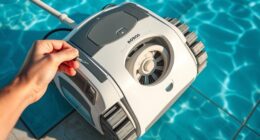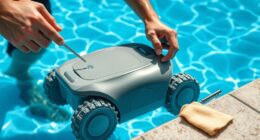You'll love how effective a mix of baking soda and white vinegar is for stubborn baked-on food. Just combine them to create a powerful cleaning solution. Gently scrub with a nylon pad or sponge after applying the mixture. Let it sit for a bit to work its magic. For extra tough stains, consider using hydrogen peroxide for soaking. This surprising combination will leave your pans looking brand new. Mastering this simple trick will have you amazed at the results. Now, discover more tips and tricks to keep your kitchen sparkling clean!
Key Takeaways
- Baking soda paste with white vinegar shocks off baked-on food effectively.
- Utilize hydrogen peroxide soaking for stubborn stains removal.
- Gentle scrubbing with steel wool aids in cleaning without scratching.
- Hot, soapy water helps loosen tough residues for easier cleaning.
- Regular soaking with baking soda or white vinegar maintains pan cleanliness.
Testing Cleaning Methods
When testing cleaning methods for removing baked-on food, you found that various combinations of baking soda, white vinegar, and hydrogen peroxide produced different levels of effectiveness.
The combination of baking soda and white vinegar required a lengthy 60-minute soak and significant scrubbing to tackle tough stains on baking sheets. Despite its effectiveness, this method was rated lower compared to other combinations.
For instance, the baking soda and hydrogen peroxide paste garnered a 4/5 rating for lifting stains with light scrubbing needed after a 6-hour soak.
In dealing with stubborn residues, scrubbing tools like steel wool proved to be indispensable. Steel wool, known for its abrasive nature, was particularly effective in aiding the removal of baked-on food remnants.
Baking Soda + Water

So you want to tackle those baked-on food stains using baking soda and water.
The key is to let the paste sit for 30 minutes to work its magic before scrubbing for an additional 15 minutes.
Remember to use a nylon pad, sponge, or brush to effectively remove the residues and stains.
Soaking for Effective Cleaning
To effectively clean baked-on food from your pans, start by soaking them in a baking soda and water paste for 30 minutes. This soaking method is particularly useful for lighter staining or nonstick pans that require gentle cleaning.
By immersing your pans in hot water mixed with baking soda, the paste works to loosen the stubborn residue, making it easier to remove. The hot water helps to activate the baking soda's cleaning properties, enhancing its effectiveness in breaking down the baked-on food.
After the soaking period, you can further facilitate the cleaning process by gently scrubbing the pans with a nylon pad, sponge, or brush. This combination of soaking and scrubbing can be a time-efficient and natural solution for dealing with mild to moderate stains on your baking sheets.
Scrubbing Techniques Required
For effective removal of baked-on food using a baking soda and water paste, incorporate gentle scrubbing techniques with a nylon pad, sponge, or brush. When tackling stubborn residues, a bit of elbow grease combined with the scouring power of a nylon pad can work wonders. Here's a breakdown of the scrubbing techniques required:
| Scrubbing Tools | Effectiveness | Ease of Use |
|---|---|---|
| Nylon Pad | High | Easy |
| Sponge | Medium | Very Easy |
| Brush | Low | Moderate |
Using these tools in conjunction with the baking soda paste allows for effective removal of lighter staining on baking sheets. While the method may require some effort, the scrubbing process typically takes around 15 minutes, making it a relatively quick and efficient cleaning solution. Remember, with the right tools and technique, even the most stubborn baked-on food can be conquered.
Baking Soda + White Vinegar

Mix baking soda and white vinegar in a 1:1 ratio to create a potent cleaning paste for dealing with baked-on food residue. This dynamic duo, consisting of common household items, proves effective in removing stubborn stains.
Soaking baking sheets in hot water with the baking soda and white vinegar mixture for 30-60 minutes helps to loosen tough residue, making it easier to scrub off. Utilizing a scouring pad or brush is vital for ensuring the successful removal of baked-on grime.
This method has been rated 4 out of 5 for its ability to combat challenging stains, but it does require some elbow grease. Baking soda and white vinegar are a formidable team when it comes to tackling baked-on food messes, offering a natural and cost-effective cleaning solution for your kitchen essentials.
Hydrogen Peroxide Soaking

You can benefit from soaking your baking sheets in hydrogen peroxide to lift stubborn baked-on food stains.
It's important to note the best soaking duration and the significance of scrubbing with a scouring pad after soaking.
These points will help you effectively remove light to moderate residues from your baking sheets.
Benefits of Soaking
Soaking baking sheets in hydrogen peroxide can effectively lift tough, baked-on stains with minimal scrubbing effort.
Here are some benefits of using hydrogen peroxide soaking for cleaning your baking sheets:
- Efficient Cleaning: Hydrogen peroxide is one of the best ways to clean baked-on stains as it breaks down the grime effectively.
- Less Scrubbing: With hydrogen peroxide soaking, you can let it sit and work its magic, reducing the need for vigorous scrubbing.
- Easy Stain Removal: Light stains are easily removed through hydrogen peroxide soaking, making the cleaning process simpler.
- Deep Stain Treatment: For deep and stubborn stains, longer soaking times with hydrogen peroxide can help in lifting the grime effectively.
- Maintenance and Restoration: Using hydrogen peroxide soaking regularly can assist in maintaining the cleanliness of your baking sheets, keeping them in top condition.
Soaking Duration Tips
For ideal results when using hydrogen peroxide soaking for cleaning baked-on food, consider soaking your baking sheets for a minimum of 6 hours. This duration allows the hydrogen peroxide to penetrate and loosen the stubborn stains effectively. However, if you are dealing with tougher, baked-on food residues, you may need to extend the soaking time for better results. The hydrogen peroxide works by lifting and loosening the stains, making it easier for you to scrub them off afterwards.
To give you a clearer idea of soaking durations based on the level of residue, here is a helpful table:
| Food Residue Level | Soaking Duration |
|---|---|
| Light | 6-8 hours |
| Moderate | 8-12 hours |
| Heavy | 12-24 hours |
Scrubbing After Soaking
After soaking baking sheets in hydrogen peroxide for the recommended duration, the next step involves scrubbing off the loosened baked-on food residues using a scouring pad.
Here are some tips for effective scrubbing after soaking with hydrogen peroxide:
- Use a back-and-forth motion while scrubbing to guarantee even removal of residues.
- Apply moderate pressure to the scouring pad to address stubborn spots without damaging the baking sheet.
- Rinse the baking sheet periodically while scrubbing to eliminate lifted residues and evaluate remaining areas that need more attention.
- Focus on areas with heavier buildup by dedicating extra time and effort during scrubbing.
- Repeat the scrubbing process if necessary, especially for deeply ingrained stains that may necessitate multiple rounds of soaking and scrubbing.
Baking Soda + Hydrogen Peroxide Paste

Try combining baking soda and hydrogen peroxide to create a powerful paste for tackling baked-on food residue. This dynamic duo works wonders in lifting tough stains from your baking sheets.
Start by mixing baking soda and hydrogen peroxide to form a thick paste. Spread this paste evenly over the affected areas on the baking sheet, ensuring complete coverage. Let the paste sit for at least 6 hours to allow it to penetrate and loosen the stubborn food residue.
The combination of baking soda and hydrogen peroxide creates a potent cleaning solution that helps break down the baked-on food with minimal scrubbing required. While this method may take a bit longer due to the soaking time, it's highly effective in restoring heavily soiled baking sheets to a like-new condition.
The bubbling action of the hydrogen peroxide and the abrasive nature of baking soda work together to tackle even the most stubborn stains. Give this baking soda and hydrogen peroxide paste a try for deep cleaning and revitalizing your baking sheets.
Pretreating Your Pans

To effectively pretreat your pans for removing baked-on food, consider creating a cleaning paste with baking soda or cream of tartar plus white vinegar. This paste works wonders in loosening tough stains and residues before you start scrubbing.
Here are some tips to help you get those pans sparkling clean:
- Make a cleaning paste by mixing baking soda or cream of tartar with white vinegar.
- Let the paste sit on the pan for at least 30 minutes to work its magic.
- Use steel wool or scouring pads along with hot, soapy water for stubborn stains on baking sheets.
- Baking soda and white vinegar are common household items perfect for pretreating pans.
- Proper pretreatment not only helps in lifting baked-on food residues but also makes the scrubbing process much easier.
Get ready to tackle those tough stains with this simple yet effective cleaning method!
Get Ready to Scrub

Prepare your cleaning tools and arm yourself with determination as you gear up to scrub away the baked-on food from your pans.
For dirty baking sheets, the combination of hot, soapy water and steel wool can work wonders in breaking down tough, stuck-on residues.
However, when dealing with nonstick pans, it's essential to tread lightly. Avoid scratchy materials that could harm the delicate nonstick surface. Instead, consider pretreating the pan with a mixture of baking soda and vinegar to help loosen stubborn stains before gentle scrubbing.
Frequently Asked Questions
What Cleaning Agent Best Removes Baked on Food?
When removing baked-on food, white vinegar and baking soda create a powerful cleaning paste. Let it sit for 30 minutes, then scrub with steel wool. Regular pretreatment with this combo can prevent stubborn buildup.
What Dissolves Baked Grease?
To dissolve baked grease, try using baking soda and white vinegar for a powerful cleaning paste. Alternatively, mix cream of tartar with white vinegar. Soak pans in hot, soapy water with baking soda. Scrub with steel wool or scouring pads.
Will Baking Soda and Vinegar Remove Baked Grease?
Using baking soda and vinegar will effectively remove baked grease. The abrasive baking soda helps lift stubborn residue, while vinegar's acidity breaks down grease. Soak, scrub, and be amazed at how this natural solution works wonders.
How to Get Black Baked on Grease off Pans?
To get black baked-on grease off pans, soak them in a mix of hot water, baking soda, and white vinegar for an hour. Then scrub with a scouring pad like a warrior in battle until clean. Maintenance prevents future buildup.
Conclusion
You've tried all the DIY methods, but nothing seems to work, right?
Well, get ready to be amazed because the secret to removing baked-on food is finally here! This cleaning agent will shock you with its powerful results.
Say goodbye to scrubbing endlessly and hello to easy cleaning. It's time to make your pans sparkle like never before!










